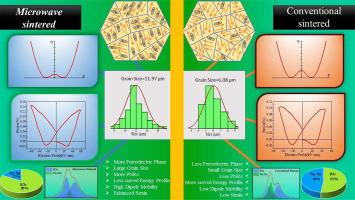Enhanced piezoelectric properties via microwave sintering in La3+- doped BiFeO3–BaTiO3 lead-free piezo-ceramics
IF 5.7
3区 材料科学
Q2 MATERIALS SCIENCE, MULTIDISCIPLINARY
引用次数: 0
Abstract
Piezoelectric energy harvesters (PEHs) have significant potential to provide a sustainable solution for low-grade energy harvesting and battery-less powering systems from physiological monitoring to internet-of-things applications. To access the performance of devices and the suitability of the material, figure-of-merit (FOM) are investigated. From an application perspective, lead-free ferroelectric materials with high figures of merit require enhancements in their ferroic functionalities. In this study, a balanced combination of properties is realized in BiFeO3–BaTiO3 (BF-BT) ceramics through microwave sintering (MS) and precise La3+ doping. This approach leverages the synergistic effects of optimizing grain size to enhance the electrostrictive coefficient and stabilizing the domain orientation via polar nanoregions (PNRs), resulting in outstanding electrical properties, including a high TC = 502 °C, d33 = 191 pC/N, and FOM = 5888 × 10–15 m2/N. These findings highlight the potential of MS-engineered BF-BT ceramics to meet the demands of advanced PEHs, opening new possibilities for creating wireless sensors which are self-powered and capable of operating in high-temperature surroundings.

微波烧结提高La3+掺杂BiFeO3-BaTiO3无铅压电陶瓷的压电性能
压电能量收集器(PEHs)具有巨大的潜力,可以为从生理监测到物联网应用的低等级能量收集和无电池供电系统提供可持续的解决方案。为了获得器件的性能和材料的适用性,研究了性能图(FOM)。从应用的角度来看,具有高品质的无铅铁电材料需要增强其铁功能。在本研究中,通过微波烧结(MS)和精确的La3+掺杂,实现了BiFeO3-BaTiO3 (BF-BT)陶瓷性能的平衡组合。该方法利用优化晶粒尺寸的协同效应,通过极性纳米区(pnr)提高电致伸缩系数和稳定畴取向,从而获得出色的电学性能,包括高TC = 502°C, d33 = 191 pC/N, FOM = 5888 × 10-15 m2/N。这些发现突出了ms工程BF-BT陶瓷在满足先进PEHs需求方面的潜力,为创造自供电且能够在高温环境中工作的无线传感器开辟了新的可能性。
本文章由计算机程序翻译,如有差异,请以英文原文为准。
求助全文
约1分钟内获得全文
求助全文
来源期刊

Materials Research Bulletin
工程技术-材料科学:综合
CiteScore
9.80
自引率
5.60%
发文量
372
审稿时长
42 days
期刊介绍:
Materials Research Bulletin is an international journal reporting high-impact research on processing-structure-property relationships in functional materials and nanomaterials with interesting electronic, magnetic, optical, thermal, mechanical or catalytic properties. Papers purely on thermodynamics or theoretical calculations (e.g., density functional theory) do not fall within the scope of the journal unless they also demonstrate a clear link to physical properties. Topics covered include functional materials (e.g., dielectrics, pyroelectrics, piezoelectrics, ferroelectrics, relaxors, thermoelectrics, etc.); electrochemistry and solid-state ionics (e.g., photovoltaics, batteries, sensors, and fuel cells); nanomaterials, graphene, and nanocomposites; luminescence and photocatalysis; crystal-structure and defect-structure analysis; novel electronics; non-crystalline solids; flexible electronics; protein-material interactions; and polymeric ion-exchange membranes.
 求助内容:
求助内容: 应助结果提醒方式:
应助结果提醒方式:


